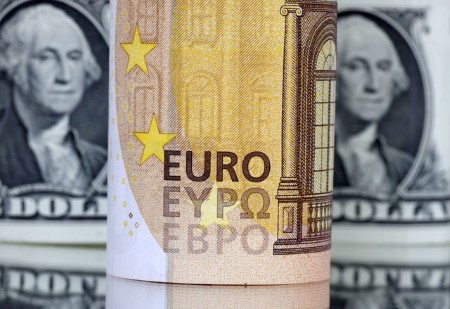Jan 26 (Reuters) –The dollar index trimmed its losses on Friday after December’s 0.7% surge in personal spending, with core PCE readings a shade below forecast and only marginally reducing the odds of a March Fed rate cut ahead of next week’s key U.S. data, Fed and BoE meetings.
The dollar slipped against the euro, but gained against the yen following far below forecast January Tokyo CPI readings. The core CPI rate fell from 2.1% to 1.6%, well below the 1.9% forecast.
But the drop was largely due to tumbling fuel prices. The ex-food and fuel reading fell to 3.1% from 3.5%, still well above the BoJ’s 2% target, but trending lower.
However, B-to-B service inflation rose 2.4%, with November revised to 2.4% from 2.3%, which could favor the BoJ outlook that cost-push inflation might be followed by demand-led inflation, assuming this year’s wage increases are sufficient to support that. Broad-scale wage settlement information won’t be available until the BoJ’s late-April meeting. Futures don’t fully price in a rate hike until June.
A first Fed cut in March has slipped to a 47% probability, with 134bp of cuts by year-end. Markets are having a hard time visualizing the Fed rapidly refilling the proverbial punchbowl with surging consumer spending, the jobless rate not far from all-time lows and equity markets hitting record highs, despite core PCE at the Fed’s 2.0% rate in both Q3 and Q4.
Futures markets remain convinced the ECB will cut rates at their April 11 meeting, perhaps beating the Fed to the exit that month, after being four months behind the Fed in raising rates in 2022.
As the week winds down ahead of a busy U.S. data schedule, with Fed and BoE announcements on Wednesday and Thursday, the dollar index remains just above where it began Monday.
EUR/USD rose 0.08% on Friday and fell 0.4% on the week, with worries about the euro zone economy, particularly Germany’s, weighing.
USD/JPY rose 0.34% and was flat on the week.
Sterling fell 0.08% on Friday and was flat on the week. Markets still foresee the BoE being slower in cutting rates than the Fed or the ECB this year. The BoE faces the task of trying not to harm the economy in the face of stickier inflation than in the U.S. or the euro zone.
Next week’s U.S. JOLTS, ADP, ISM manufacturing and employment reports, along with the post-Fed and BoE takeaways, appear to be the best potential catalysts to end the recent dollar stagnation.
For more click on FXBUZ
Editing by Burton Frierson
Randolph Donney is a Reuters market analyst. The views expressed are his own.



